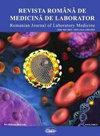Change of routine coagulation parameters in plasma samples with different hematocrit values
IF 0.5
4区 医学
Q4 MEDICINE, RESEARCH & EXPERIMENTAL
引用次数: 0
Abstract
Abstract Aim There are many preanalytical variables affecting routine coagulation tests. Increased hematocrit (Htc) levels are one of these variables. However, no study has been conducted to determine the effect of low Htc values on coagulation tests. Therefore, in this study, we aimed to evaluate whether low Htc values affect coagulation tests besides high Htc values. Methods Standard human plasma was injected into coagulation tubes containing 3.2% sodium citrate to reflect hematocrit rates of 5% to 75% and prothrombin time (PT), active partial thromboplastin time (aPTT), thrombin time (TT) and fibrinogen measurements were performed. Results Three groups were formed according to Htc levels: A (5-25%), B (30-50%) and C (55-75%). PT (s) were found 13.7±0.30 in group A, 14.88±0.57 s in group B, 20.16 ±4.66 s in group C respectively. aPTT (s) results were 35.79±1.39 s in group A, 42.48 ± 3.51 s in group B and 76.47 ± 31.55 in group C. TT (s) results were found to be 26.42 ± 0.77 s (group A), 28.24±1.17 s (group B) and 32.02±2.60 (group C). Fibrinogen levels (g/L) were measured as 2.30 ± 0,05, 2.21 ± 0,07 and 1.90 ± 0.20 in groups A, B, C, respectively. For all measured parameters, group A reflecting low Htc was significantly (P < 0 ,0001) different from the other groups. Conclusion Previous studies have reported that high Htc (> 55%) levels affected routine coagulation tests. In our study, low Htc (5-25%) values were also shown to cause errors in the test results.不同红细胞压积值血浆样品常规凝血参数的变化
目的影响凝血常规检查的分析前变量很多。红细胞压积(Htc)水平升高是这些变量之一。然而,目前还没有研究确定低Htc值对凝血试验的影响。因此,在本研究中,我们旨在评估除了高Htc值外,低Htc值是否会影响凝血试验。方法将标准人血浆注入含有3.2%柠檬酸钠的凝血管中,反映5% ~ 75%的红细胞压积率,测定凝血酶原时间(PT)、活性部分凝血活酶时间(aPTT)、凝血酶时间(TT)和纤维蛋白原。结果按Htc水平分为A组(5 ~ 25%)、B组(30 ~ 50%)、C组(55 ~ 75%)。PT (s) A组为13.7±0.30 s, B组为14.88±0.57 s, C组为20.16±4.66 s。aPTT (s)结果A组为35.79±1.39 s, B组为42.48±3.51 s, C组为76.47±31.55 s。TT (s)结果分别为26.42±0.77 s (A组)、28.24±1.17 s (B组)和32.02±2.60 (C组),纤维蛋白原水平(g/L)分别为2.30±0.05、2.21±0.07和1.90±0.20。对于所有测量参数,反映低Htc的A组与其他组有显著差异(P < 0.0001)。结论既往研究报道高Htc(> 55%)水平影响常规凝血试验。在我们的研究中,低Htc(5-25%)值也会导致测试结果出现错误。
本文章由计算机程序翻译,如有差异,请以英文原文为准。
求助全文
约1分钟内获得全文
求助全文
来源期刊

Revista Romana De Medicina De Laborator
MEDICINE, RESEARCH & EXPERIMENTAL-
CiteScore
0.31
自引率
20.00%
发文量
43
审稿时长
>12 weeks
期刊介绍:
The aim of the journal is to publish new information that would lead to a better understanding of biological mechanisms of production of human diseases, their prevention and diagnosis as early as possible and to monitor therapy and the development of the health of patients
 求助内容:
求助内容: 应助结果提醒方式:
应助结果提醒方式:


